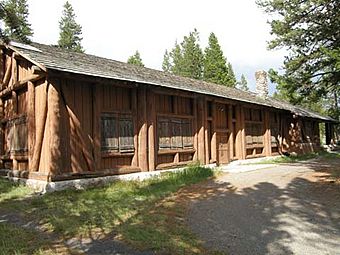Lake Fish Hatchery Historic District facts for kids
Quick facts for kids |
|
|
Lake Fish Hatchery Historic District
|
|
 |
|
| Location | Yellowstone Lake, Wyoming |
|---|---|
| Built | 1930 |
| Architect | U.S. Fish and Wildlife Service |
| MPS | Yellowstone National Park MPS |
| NRHP reference No. | 85001416 |
| Added to NRHP | June 25, 1985 |
The Lake Fish Hatchery Historic District is a special area in Yellowstone National Park. It has nine old buildings that were built between 1930 and 1932. These buildings were made by the U.S. Fish and Wildlife Service. They all share a similar look, called the National Park Service Rustic style. This style uses exposed wooden beams and large logs at the corners. The buildings are located right on the shore of Yellowstone Lake.
The main purpose of this place was to collect eggs from Yellowstone cutthroat trout. These eggs were then sent to other fish hatcheries across the United States.
Contents
Why the Hatchery Was Built
In the early 1900s, many fish hatcheries were set up in Yellowstone National Park. Two of these were at Yellowstone Lake and Soda Butte Creek. The current Lake Fish Hatchery replaced an older one at the lake.
These hatcheries helped stock fish in the park's waters. They also used the large number of Yellowstone cutthroat trout to get eggs. These eggs were then sent to other hatcheries all over the U.S. From 1901 to 1953, over 818 million trout eggs left the park!
Impact on Fish in Yellowstone
The fish hatcheries and stocking programs had both good and bad effects. For a while, they made fishing better for some types of fish. For example, you could find good brown and rainbow trout fishing in the Firehole River, Madison River, and Gibbon River.
However, these programs also caused problems for native fish. Many local fish populations were replaced by fish that didn't naturally live there. This hurt the numbers of native Yellowstone cutthroat, westslope cutthroat trout, and Arctic grayling.
Because of these negative effects, the National Park Service decided to stop the programs. They began closing the hatcheries in 1953. The last fish were stocked in 1955. By then, about 310 million fish had been released into the park's waters since 1889. The very last hatchery closed its doors in 1957.
Buildings in the District
The Lake Fish Hatchery Historic District includes several important buildings. They all show the unique "National Park Service Rustic" style.
The Main Office and Mess Hall
Building 725 is the most important building in the district. It used to be the mess hall for the Fish and Wildlife Service workers. Now, it serves as the South District Office for the park. This building was built in 1935. It uses a special building method called "logs out." This means the log frame is visible on the outside, making the inside walls smooth.
The Hatchery Building
Building 726 was the actual fish hatchery. It was built around 1930. This one-story building is quite large. It has a cool arched log design at one end and a stone chimney. The hatchery was even designed for visitors! It had an aquarium area with glass panels. This let people see the fish in the tanks. There was also a balcony above the hatching troughs.
Other Buildings in the District
- Building 729: This was the office and summer home for the hatchery director. It was built in 1932.
- Buildings 730 and 731: These were smaller homes, built around 1931.
- Building 732: This was a garage with six bays, built in 1930.
- Building 733: This building was a bunkhouse for the Fish and Wildlife Service workers, built in 1930.
- Buildings 735 and 737: These were a wash house and an oil house, completing the group of buildings.
Some other structures like boathouses, a dock, and rearing ponds were also built. However, these have not survived over time.
The district was first managed by the U.S. Fish and Wildlife Service. But after the fish hatchery stopped working, the National Park Service took over. The old mess hall became a park office. The former bunkhouse also became park offices. The Lake Hatchery was added to the National Register of Historic Places on June 25, 1985.
Images for kids










